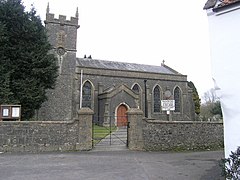Stoke St Michael
| Stoke St Michael | |
|---|---|
 Church of St Michael |
|
| Stoke St Michael shown within Somerset | |
| Population | 926 (2011) |
| OS grid reference | ST665465 |
| District | |
| Shire county | |
| Region | |
| Country | England |
| Sovereign state | United Kingdom |
| Post town | RADSTOCK |
| Postcode district | BA3 |
| Dialling code | 01749 |
| Police | Avon and Somerset |
| Fire | Devon and Somerset |
| Ambulance | South Western |
| EU Parliament | South West England |
| UK Parliament | |
Stoke St Michael is a village and civil parish on the Mendip Hills 4 miles (6.4 km) north east of Shepton Mallet, and 8 miles (12.9 km) west of Frome, in the Mendip district of Somerset, England.
Since the 14th century the village has also been known as Stoke Lane, although the origin of the alternative name is unclear, but may be connected to John de Lison who gave lands in the village to Glastonbury Abbey in 1253. The parish of Stoke Lane was part of the Whitstone Hundred.
The village became a centre for cloth manufacture with fulling mills being established on the River Frome to the north of the village. Henry Fussell established paper mills in 1803, and his family, who came from the village, including James Fussell established their iron works and edge-tool business in Mells.
The Knatchbull Arms was built in the late 17th century, and is named after the Knatchbulls of Babington who held the manor in the late 18th century.
The manor house on Tower Hill, which was previously known as the old vicarage, was built around 1700.
The parish council has responsibility for local issues, including setting an annual precept (local rate) to cover the council’s operating costs and producing annual accounts for public scrutiny. The parish council evaluates local planning applications and works with the local police, district council officers, and neighbourhood watch groups on matters of crime, security, and traffic. The parish council's role also includes initiating projects for the maintenance and repair of parish facilities, as well as consulting with the district council on the maintenance, repair, and improvement of highways, drainage, footpaths, public transport, and street cleaning. Conservation matters (including trees and listed buildings) and environmental issues are also the responsibility of the council.
...
Wikipedia

